St. Louis Cultural History Project—Spring 2020

I am not writing for posterity—just for special occasions. Others may create art, but I’m just a good literary plumber.1
Lord of the Pamphlets: Daniel A. Lord, S.J.
By Stephen Werner, Ph.D.
“Ultimately he became the greatest Catholic pamphleteer of his time . . .”2
“This Master of Pamphlets: America’s ace Catholic pamphleteer has reason to know that the pen is still mightier than the sword.”3
The Life of Daniel Lord
Daniel A. Lord, S.J. (1888-1955) was one of the most influential religious figures in America in the twentieth century. 4 He grew up in Chicago and attended the combined St. Ignatius high school and college. In 1909, he entered the Jesuits at St. Stanislaus Seminary outside of St. Louis and was ordained in 1923.
From 1925 to 1949, Lord ran the Queen’s Work office in St. Louis which coordinated over 13,000 Sodalities across the country. Sodalities were clubs to encourage faith at Catholic high schools, colleges, and parishes. Lord created Student Leadership Conferences and the popular Summer School of Catholic Action, a week long conference of Sodality members.5
Lord started working with young people and writing for them at a critical time in American history. The growing Catholic population needed more schools. As child labor laws and mandatory education laws became more common many young people were freed from the need to work. A high school education became the norm and young people had more time for other activities. Lord thought that living out their Catholic faith could be one of those activities. “Father Lord found in the expanding American Catholic high school system a splendid opportunity for promoting religious life of the students through the sodality.”6
In 1927 Lord went to Hollywood to serve as Technical Adviser on the silent film The King of Kings directed by Cecil B. DeMille.7 Lord wrote the controversial 1930 Motion Picture Production Code giving guidelines for movie content and the 1936 papal encyclical on movies: Vigilanti Cura.8 He was also the key catalyst of the American Catholic Literary Revival of the 1930s and 1940s.9
Catholic historian Jay Dolan summarized the impact of Lord:
In keeping with the 20th-century emphasis on the apostolate of the young, the sodality movement experienced a renaissance in the 1920s and 1930s. The main force behind this was the Jesuit priest Daniel Lord. . . . He promoted the sodality and its appeal and its special brand of devotional Catholicism in a variety of ways: through a magazine, pamphlets, theater, summer schools of Catholic action, and national conventions.10
During his career, Lord wrote 48 books and booklets and 70 children’s books. He also wrote some 70 theatrical shows. Some were small plays for grades schools; others were large musical pageants with casts of over a 1,000, leading someone to call Daniel Lord “a frocked Cecil B. DeMille.” And Daniel Lord wrote pamphlets.
Pamphlets
Daniel Lord’s most important writings, his pamphlets, are easy to dismiss because they are, after all, just pamphlets. However, Lord wrote 228 of them covering the entire scope of Catholic faith and life: everything from the sacraments, to marriage and divorce, to naming a child and child safety. Daniel Lord did not write timeless literature to be studied by academics, instead he wrote for ordinary people dealing with current issues. He wrote in a very straightforward, easy to understand style, yet he did not ‘dumb it down.’ For example, his 1930 pamphlet I Can Read Anything expected the reader to know about Dumas, Hemingway, Ibsen, Noel Coward, and Bertrand Russell.
His main market for selling pamphlets was the hundreds of thousands of Sodality members, especially young Sodalists, around the country. The Queen’s Work sold pamphlet racks that were put in schools and parishes and often maintained by Sodalists. During World War II pamphlet racks were even found on Navy ships.
In part, Lord was motivated by the success of the E. Halderman-Julius Publishing Company of Girard Kansas, publisher of Little Blue Books that initially sold for five cents a copy. The effort ran from 1919-1978 and sold over 300 million copies. The topics of the books covered philosophy and literature, but also salacious subjects such as The Love Affair of a Priest and a Nun, Curious and Unusual Love Affairs and anti-religious subjects such as 61 Reasons for Doubting the Bible and Why I Reject the Idea of God.11 Lord noted:
To the school of “thinkers” who spawn from Girard, Kansas, and who pour forth the discredited scientific nonsense of fifty years ago at five cents a booklet along with information on how to be happy and love, how to be successful in business without brains or training or how to read palms and draw horoscopes.12
Yet I know one popular publishing firm that floods the country with the booklets and no more hesitates about its methods than a common gangster. It is just a gang of literary pirates scuttling the ship of faith, flying a Jolly Roger, willing to use any sort of weapon—false history, twisted fact, plain lies—to beat down faith and break down morality. What a fool any man is who puts his mind in the power of ruthless brigands like that, who hate the faith and Christian morality so intensely that they stop at nothing if only they can thrust a poisoned dagger home.13
Lord’s first pamphlet success was The Story of the Little Flower published by Benziger Brothers in 1925 just as Thérèse of Lisieux was being canonized.14 It sold well and Lord saw the potential for pamphlets.
As I once lay on my bed in a Catholic hospital, I was visited by two unknown spinsters who popped pamphlets out of their bags and left me, a young Jesuit at that time, looking at Protestant propaganda on drunkenness and how to pick a wife.15
Once, on a train out of Chicago, an “American Catholic” gave him a pamphlet proving from the Bible that the world was flat. He found Theosophy pamphlets inside books covers in the public library. “This was all in the days before communism let down its snowfall of pamphlets, and Judge Rutherford [Jehovah’s Witnesses leader] shot pamphlets into every corner of the world, . . .”16
As he started having more contact with young people Lord figured out the obvious:
1. They read as little as possible.
2. What they do read must be brief in form, and catch them in the first sentence.
3. They won’t read a big book if they can read a small one; they won’t read a small books if they can read a booklet; they won’t read a booklet if they can read a pamphlet.17
In autumn of 1926, on the train to California to meet Cecil B. DeMille, Lord wrote Shall I Be a Nun. Lord then created Queen’s Work publishing with its own print shops and its own distribution system through the Sodalities. Queen’s Work publishing would last until the 1960s and print, sell, and give away many millions of pamphlets, books, and booklets by Lord and others. Pamphlet Design and Inspiration
Lord wanted something that would fit into the inside pocket of a man’s coat or a woman’s handbag. He also wanted the pamphlet to fit into an ordinary envelope so that someone could mail it to a friend. Lord settled on a small size: Shall I Be Nun? (1927) is 3 1/4 inches wide and 6 inches tall. It runs to 32 pages. It contains eight sheets of paper folded and stapled with a cover. Each sheet, printed on both sides, held four pages. Later pamphlets would be 32, 36, 40, 44, or 48 pages depending on whether eight sheets or up to twelve were used.
It should be some thing that could be read through in an hour by a reader of normal speed. It must be inconspicuous enough to be read without self-consciousness on a streetcar or bus, in a railroad station or on a train; and yet the cover must have appeal sufficient to make a casual passer-by stop and reach out to investigate it further. The title must tell the story of the content in a few stimulating words. The buyer must know exactly what he is getting. Hence tricky titles, ambiguous titles, to me were bad. The style should be such as would be clear to a mildly intelligent teen-ager and yet no insult to the intelligence of an adult.18
Lord focused each pamphlet on one subject and he often wrote ten or more a year.
Lord and his printing staff tried all kinds of colors and designs with drawings and photographs for the covers: “everything that would catch the eye of the possible reader, give a hint to contents, and yet not brand the reader in the eyes of chance observers as a goody-goody poring over some Sunday School tract.”19 Lord often used catchy titles such as What Catholicity and Communism Have in Common (1936), Is Religion Bad for Your Mind? (1946), Spinsters Are Wonderful People (1947), What Catholicity and Communism Have in Common (1936), and Don’t Marry A Catholic (1952).
Lord kept a desk drawer of miscellaneous jottings and pamphlet ideas. Each spring he sorted through the drawer looking for “hot” topics.20 Before writing on a particular topic, Lord gave it several times as a talk, working out what he wanted to say. Once written, each pamphlet went through several drafts before being checked by proofreaders on his staff. Finally, it went to the censors who were often Lord’s fellow Jesuits.
Lord Pamphlets by Category
Daniel Lord was the most prolific American Catholic writer. What follows is a description of Lord’s pamphlets by categories. Numerous Lord quotes are included to give a feel for his writing style and to show the wide range of topics he covered. Lord’s writings give a window into the American Catholic world from the 1920s into the 1950s.
Lord’s pamphlet writing began in earnest in 1927 and lasted until the last months of his life. Each year he created a Christmas pamphlet with a colorful cover such as For Us the Christmas Joy (1936); Christmas with Mary (1947); and A Star, a Child, and a Stable (1948). He also wrote fourteen novena pamphlets and some seventeen devotional pamphlets that were also catechetical such as I Don’t Like Lent! (1937), The Man the Savior Praised: St. John the Baptist (1943), and Our Lady’s Assumption (1934).
Lord wrote fourteen pamphlets on the sacraments such as Confession is a Joy? (1933), The Sacrament of Catholic Action: Confirmation (1936), Attention, Godparents! (1951), and That Wonderful Sunday Mass (1955).
ApologeticsAbout two dozen Lord pamphlets fall into the category of apologetics. He wrote pamphlets about Catholic faith and belief such as Christ the Modern (1932), Atheism Doesn’t Make Sense (1936), Faith Is a Chain (1939), Man Says “If I Were God . . .” (1940), What Catholics Think of Christ (1948), and What Catholics Think of the Church (1948).
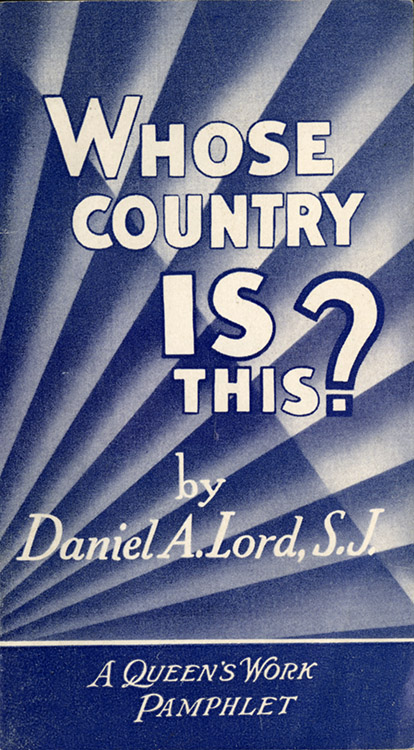
Other pamphlets defended the Catholic Church from attacks from its critics: The Church Is Out of Date (1935), St. Peter: Pope or Impostor? (1947), and The Church Can’t Order Me! (1954). His 1932 pamphlet, Whose Country is This? , told of a golf game where Mr. Overman brings up all the Anti-Catholic prejudices of the time and Catholic Mr. Floyd answers them. Lord wrote this pamphlet only a few years after the 1928 presidential campaign which was marked by virulent attacks against candidate Al Smith because he was Catholic.
In The Church Is a Failure? (1939) Lord wrote:
The Church is not an ethical-culture society conducting classes in abstract truths or aesthetic entertainment. It’s a tough organization demanding a lot of hard things for its members.21
The Church bravely and with sublime and often apparently unfounded optimism goes on making terribly difficult demands.22
After nineteen hundred years of pretty bitter and disillusioning experience the Church holds to her unfaltering belief in humanity.23
Catholic Education
Lord wrote several pamphlets on the importance of Catholic education, especially at Catholic Colleges: Murder in the Classroom (1931) and The Magnificent Catholic College (1954).
We must not forget that Catholicity is not merely an external form; it is a system of life and living. It is a historic tradition 2000 years old. It is faith permeating knowledge and supported by the cold, clear reasonings of philosophy and science. It is art and music and beauty and literature and drama all in one magnificent unity. It is big enough to take in the latest findings of science and yet to remember the undying words of Christ; to be interested in the last discoveries in Egypt without forgetting the God who is ages older than the pyramids; to be ever as modern as the day and as enduringly ancient as the rock of Peter.24
Do You Love Your Children? (1952), an argument for Catholic education, Lord rejected the idea that “Religion is a Cinch.”
If religion is a cinch—easy, simple, a push-over—it’s the only thing in modern life that is. Education is the effort to get young people to understand some little part of this complicated world. What does anyone get these days without study? Mathematics? Science? Medicine? Law? Literature? Language? Music? Acting? Sports?
Send him and see that he goes to religion classes offered by your Parish. See that in high school, when his confusion can easily become more bewildering and his temptations more violent, he is getting Catholic teaching along with his other studies. Your child rates no less. He is gypped if he misses that.25
Vocations
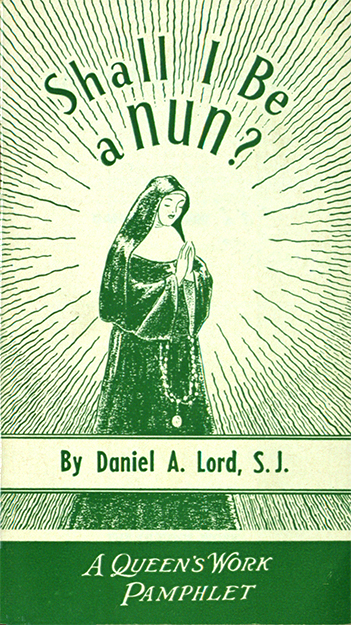
Lord wrote six pamphlets on vocations including: Shall I Be a Nun? (1927), Shall My Daughter Be a Nun? (1927), and The Call of Christ: A Study of Religious Vocation for Young Men (1927). Lord wrote these at a time when the rapidly growing Catholic school created a huge demand for sisters to staff them.26 Lord also wrote Spinsters Are Wonderful People: In Praise of Unmarried Women (1947) on the single life for women.
It does seem strange that there should be no dignified title to describe the unmarried women who were among the most important figures in our world. They are earning big salaries, holding responsible positions, directing important enterprises. They are influential executives. They are in a thousand fields of work that make for human happiness and progress.27
The Chance of a Lifetime (1946), written in the wake of World War II, is one of Lord’s more important pamphlets. He takes his call for priesthood and the religious life to a whole new level. Not just one more pamphlet on vocations, this is Lord’s bold vision for the future.
Far from being the refuges of the timid weakling, the sanctuaries and the convents are going to turn out to be the foxholes from which heroes and heroines will roll back the assaults of the most savage foe. The cloisters are not the abodes of the frightened; they are the pillboxes, the PT boats, the Marauders of God’s fighting army.28
This is a booklet for heroes and heroines. All others will waste their time if they read it.29
Lord notes that sometimes people who enter the sanctuary or convent are accused of cowardice for trying to escape the real world. “Plausible as it may sound, it turns out to be the most arrant nonsense.”1 Lord offers his “Tough Invitation”: “I should want fighting men and women prepared to enter the toughest battle the world can ever know, the struggle of God against evil, of right against wrong, of the powers of light against the powers of darkness.”1
Through Sodality conferences and his writings Lord had contact with countless young people. He also carried on extensive correspondence with tens of thousands of people. Lord, referring to his letter writing as his First Apostolate, probably wrote over 100,000 personal letters. Very likely Lord influenced hundreds of young people to enter the convent or seminary. He even admitted that some fathers had threatened to kill him for encouraging their daughters to become nuns.
In the current age of few vocations and many young people lacking an interest in religion, the writings of Lord provide an example of how to successfully communicate with young people that deserves to be looked at anew.
If Dan Lord were alive in 2017, he would have a Facebook page and a Twitter account, and he would be using them all the time to evangelize young people. Father Lord’s Jesuit colleague, Father Walter J. Ong, would later theorize about media and communication: Lord actually used all of the various forms available to attract young people to the Catholic Church: books, magazines, radio, music, musical theater, ordinary theater, pamphlets, children’s books, coloring books, and more.
John Waide, St. Louis Archivist
The Meaning of Life
Several pamphlets dealt with the meaning of life, such as his 1940 pamphlet You’ve a Right to Be Happy Lord wrote:
Frankly I wonder that God hasn’t long since tired of the whole stupid business and said, with a shrug of His divine shoulders, “All right then, my fine fellows; be as miserable as you wish. I’ve done all I could to make you happy. But have it your own way. Stew in your own unhappiness. Have a good hard cry in the midst of your handmade grief.”
For history and literature leave no slightest doubt that the vast majority of all human woes are not only man-made (as indeed are all real human miseries) but are pursued with as much energy and tireless zeal as is prospector’s gold or the fountain of youth. Off the nations march to war; though if they would read the simplest history or rake around in the ash heap of their own memories, they’d remember that war has from the dawn of remembered record been the source of nothing else but mass murder, poverty, famine—the sweeping charge of the four horsemen, followed by the dismal hangover of exhausted peace.
Men go on exploiting their fellow men, making life bleak and burdensome for them, and then wonder that the gold they coin from sweated blood doesn’t make them happy. From time immemorial men have ridden the backs of slaves and complained that the ride was uncomfortable. As if the backs of human beings were ever meant to be saddled and ridden! They have kicked the servant who waited on them and then shed tears because he didn’t love them. They have oppressed those subject to their power and have been hurt and lugubrious because the crushed didn’t welcome them home with shouts of joy and a triumphal arch.
32
Guidance on Life
Lord wrote a number of pamphlets of general guidance on living life such as How to Pick a Successful Career (1935), Are You Scrupulous? (1937), How to Write a Letter (1943), Success Through Personality (1944), Are You a Well-Balanced Person? (1948), Your New Leisure and How to Use It (1950), There’s Money in Gambling (1951), and Diet Can Be Fun (1952).
In 1939 Lord wrote How to Stay Young:
So I think the whole fundamental measure of youth comes down to this: how alert is your mind? How responsive is your soul? How quick are your reactions? How many interests have you? Is the world wonderful to you, or is it a bore? Do you find most things delightful or annoying? Are you fond of new acquaintances and devoted to old friends?33
Lord lamented the problem of modern industrialism where people have mindless repetitive jobs.
Man is essentially a creator. He must be doing things, making things. Modern industry has largely deprived him of this opportunity to create. He no longer makes a carriage; he simply stamps the trademark on the hub of the wheels. He no longer carves a statue; he handles the lever of a machine that presses out on tin ashtrays profiles of Krazy Kat.34
In his 1932 pamphlet Hours Off: What We Do When We Do Nothing Lord wrote:
Once we sang; now we go out to have people sing for us. We once danced; now we pay other people to dance for our entertainment. We once made music; now the musical instruments rust and decay while professionals strum the modern equivalent of the lute. We once played ball; we now drive to the ballpark or stadium and sit while professionals or high-priced amateurs take our exercise. And we use our automobile, not to go places, but to go places fast.35
Father Hall and the Bradley Twins
Some two dozen Lord pamphlets included the fictitious character of Father Hall who lived at Lakeside Resort. During the summer he was visited by twins Dick and Sue Bradley, two college-age Catholics. In their conversations they discussed moral issues facing young people in pamphlets such as The Pure of Heart (1928), Don’t Say it! (1929) on gossip, Speaking of Birth Control (1930), and Why Leave Home? (1931).
In his autobiography, Played by Ear, Lord would comment on Dick and Sue.
Time and again I have been asked if Dick and Sue, the Bradley twins who figure in many of the “conversational” pamphlets, are real. In a sense they are. I wrote The Pure in Heart because parents of whom I was very fond wrote me about the problem of explaining sex to their growing children. Visualizing the boy and girl whom I knew and loved, I wrote the booklet. But from that time on, Dick and Sue were likely to be the last interested teenagers who asked me a vital question. Often I have replied to youthful questioners and reviewers: “Dick and Sue might turn out to be you, if you happen to ask me a particularly interesting and timely question.” . . . . They were intelligent, alert, attractive (or so I hoped), of good middle-class environment, with the normal problems, the constant interferences and distractions of modern life; . . . 36
Father Hall also had discussions with two young friends: Ford Osborne and Helen Webb—self-identified as “two thoroughgoing pagans”—in pamphlets such as The Church is a Failure? (1939).
Dating and Marriage
Lord wrote four pamphlets on dating: What to do on a Date (1939), Why Be a Wallflower? (1940), Going Steady (1941), and So We Abolished the Chaperone (1941). He also wrote some 18 pamphlets on marriage such as Money Runs or Ruins the Home (1942), In-Laws Aren’t Funny (1948), M Is for Marriage (1950), The Man of Your Choice (1952), Don’t Marry A Catholic (1952) against religiously mixed marriages, and The Girl Worth Choosing: For the Boy Who chooses and the Girl Who wants to be Chosen (1953).
Considering Lord’s pamphlets on marriage and family, along with his five books and booklets on the subject, he produced an important body of writing on marriage. Interestingly, Lord wrote most of these in the years after World War II. Some of what he wrote is dated. For example, he was adamant against religiously mixed marriages and some of his arguments against birth control are no longer held. However, the bulk of what he wrote was straightforward and practical advice, still relevant today. In particular, Lord offered sound wisdom on the difference between romance and love, and practical guidance such as looking at a potential spouse’s family and how he or she interacts with them. Lord also wrote two pamphlets on divorce: Divorce: A Picture from the Headlines (1942), and About Divorce (1946).
Lord wrote in Your Partner in Marriage (1936):
Marriage, I repeat, is a career. But the dear young idiots who enter it have the silly idea that the start is everything. The courtship is the important thing. The honeymoon is essential. But after that? Oh marriage will take care of itself. It is the only career that does not need thought and experience and practice in a struggle for constant improvement.37 Brilliant beginners are beyond count. Those who achieve ultimate success are few indeed.38 It will continue to be a failure until people remember that it is not an adventure but a job, not a pleasure trip for a week but a career meant to last for life.39
In Is Love All That Matters? (1948) he wrote:
The preoccupation with romantic love, the conviction that “if I miss this love, I shall never know another,” rests on a strange fallacy. Somewhere in relatively recent times there grew a notion that two specific people were made for each other, these two and these two only. Marriages are not confirmed in heaven through the sacrament of Christ’s institution; marriages are arranged in heaven. It is as if definitely assigned Angels equipped with filing cards place in a certain bracket the cards of John and Jane . . . and if for some reason John and Jane do not hit it off on earth, the angels have to tear up the cards and call off any possibility of Jane’s and John’s ever marrying anyone else.40
In Romance is Where You Find It Lord wrote:
A little less infatuation before marriage and a lot more companionship and trust and affection and friendship after marriage—with God’s blessing on a wise as well as beloved choice—that, I honestly think, is the way to happiness that I pray.41
Lord’s writings on marriage were important because they influenced Edward Dowling, S.J. on Lord’s staff who worked to create Cana Conferences to better prepare young people for marriage.
Modern Literature
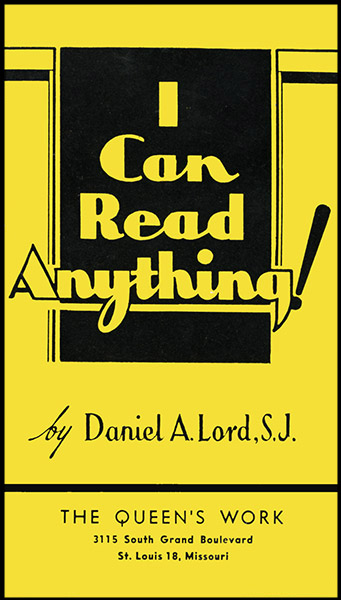
Lord wrote five pamphlets on literature: I Can Read Anything! All Right Then Read This (1930), We Pick Books for a Desert Island (1946), What Is Decent Literature? (1940), and The Best Best Seller (1932) on the gospels. Lord worked diligently to promote Catholic literature and played a key role in the American Catholic Literary Revival in the 1930s and 1940s. Lord spoke against much popular literature because he thought it promoted immorality, irreligion, and atheism.
Father Hall lamented that modern writers have put style over truth in writing: “They would slay the truth for an epigram and kill a fact to make a phrase.”42
And into this lovely form, what are the authors of the present day packing? Clever lies, smart dirt, sophistical defense of the very things that would overthrow society, brilliant characterizations of people right from the gutter and the lowest nightclubs, morality that reeks of the pigpen and the barnyard, philosophy that would cause an ancient Sophist to hide his head, and such a vague uncertainty about everything that we no longer have an honest yes and a candid no.43
Catholic Action
Lord was very likely the biggest promoter of Catholic Action in America. Catholic action was a major theme in The Queen’s Work magazine and at Sodality conferences. In 1932 Lord wrote the song For Christ the King, also know as “An Army of Youth,” for Sodality youth conventions:
An army of youth
Flying the standards of Truth,
We’re fighting for Christ, the Lord.
Heads lifted high,
Catholic Action our cry,
And the Cross our only sword.44
In his 1933 pamphlet The Call to Catholic Action, Lord gave an overview:
Catholic Action might, in consequence, be called twenty-four-hour-a-day religion. It simply communicates to the Catholic the realization that he must carry the spirit of Christ with him everywhere he goes. He must go from the communion table to bring Christ with him to his home, his office, his workshop, his classroom, his athletic field, his gymnasium, his concert hall, his theater. Christ must be invited to dominate all the activities of humanity. He may not be reserved for the brief period of a Sunday’s devotion or the swift flight of morning and evening prayer. The Catholic must take Christ with him into every form of human activity and into every field of human endeavor.45
Lord gave examples of the scope of Catholic Action. The employer must respect the dignity of the worker and the worker must give an honest day’s work. Catholic Action called the Catholic statesmen to bring honor and integrity to government, and called Catholic professionals to bring Christ into their work.
Christ goes with the workmen to his bench and the stenographer to her typewriter; with the cook to her kitchen and the mother to her nursery; with the Catholic labor leader to his union meeting; with the Catholic farmer to his fields or his cooperative society; with the aviator to his plane, the seamen to a ship, the operator to his radio station, the officer to his regiment.46
Alcohol
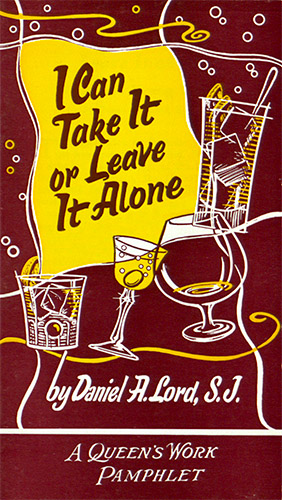
Lord wrote often about drinking. The topic came up frequently with the crowds of young people he addressed. Prohibition was in effect during the early part of his career. Lord’s 1939 pamphlet on drinking was “I Can Take It or Leave It Alone”: Drink and Young People:
I am told by young people that they have a lot of trouble at their social affairs with the young man who arrives slightly obfuscated and who brings drink along or insists on buying it; that getting drunk at private parties is by no means the unusual thing; that young women go home in cars driven by young men who were so far gone that only a long-developed driving instinct and St. Christopher keep the car from curling around the lamppost—though not always out of the path of buses and trucks and trains; that young women “pass out” on dates and wake up to find their virginity gone; that under the influence of drink young couples find themselves becoming maudlinly amorous, dangerously passionate; that some schools have had to forbid all dances and parties under school auspices—which had formally been allowed and encouraged—because of abuses at those functions.47
Lord goes on the speak of alcoholics:
Drunkards are not cured by any mere strength of will. They are physically sick people. They have acquired a habit that is based on an artificial physical need. Curing them is a long and laborious process, one that is torture to themselves and that demands infinite patience on the part of the medical men who treat them.48
“I can take it or leave it alone.”Forgive my ironic laughter.
There was never a drunkard in the making who didn’t use exactly the same chestnut—and seem to believe it. Worse: There never was a drunkard staggering through life who didn’t believe he could stop drinking anytime he made up his mind to do so. And all the while the habit was welding chains on him, creating a physical condition with which medical skill would have to struggle, often in vain.49
Lord’s thoughts on drinking were important because Edward Dowling, S.J. worked on his staff and worked to create programs for alcoholics. Dowling had a big influence on Bill Wilson, the founder of AA.
Current Events
Lord wrote a half dozen pamphlets on current events such What’s the Matter with Europe (1937) and Dare We Hate Jews? (1939) against anti-Semitism. In his 1932 pamphlet God and the Depression Lord wrote:
Suddenly the temples have been deserted. Factories no longer call for their millions. Railroad yards become on land another Saragossa Sea, choked, not with deserted ships, but with empty freight cars. Seats on the Stock Exchange that three years ago were worth half a million each are now offered at a tenth of that sum, with no takers; the seats of the mighty have lost their glamor And those with the Midas touch find that it has gone as quickly and as mysteriously as it came. Their hands are powerless to make gold; scarcely can they now make bread. Leaders who strutted arrogantly uttering wise prophecies of endless prosperity, of continued conquests, of man’s supremacy over all things, now scuttle about, cloaking their ignorance in silly excuses, blaming each other for the faults of all, and realizing that they have only words to offer to those who need food, and excuses to substitute for the failure of a boastful science that has led a world to ruin.50
Unfortunately in his pamphlets What’s the Matter with Europe (1937) and The Pope in the World Today (1938) Lord supported Pope Pius XI in not taking stronger stands against Mussolini and Hitler, seeing Communism as a bigger threat.
After World War II Lord wrote Success for the Taking with his vision for the future:
It is not merely a matter of replacing what war has destroyed—though that in itself should be a challenge to young men and women. But new and better cities must be built. Slums and tenements must disappear forever. Cities must open their arms and their highways to receive light and sun and air. Country towns must lose their ugliness, must advance toward beauty. The age of pioneering is over; the ramshackle farmhouse and the miserable flat-faced city dwelling must become a thing of beauty, a place where men can live surrounded by comfort and peace and the refinements of art. The call of business and industry today is, not a call to money-makers, but a call to men and women who will produce and make available to more and more of the earth’s people more of the good things of the earth.51
Pamphlets Against Communism
Lord wrote extensively against communism. However, he would never have supported the later witch-hunts of Joseph McCarthy. Lord thought the best way to fight communism in America was to make sure workers had adequate pay and decent working conditions. In 1936 Lord wrote What Catholicity and Communism Have in Common:
There must be revolution. On that both agree. The Communist says a political and economic revolution merely. The Catholic says a political and economic revolution brought by a revolution that is personal and individual. And the personal, individual revolution is the more important.52
The Communist demands the dictatorship of the proletariat. The Catholic repudiates all dictatorships as an extension and continuance of tyranny. Instead, he asks for worldwide cooperation—of individuals with individuals, of classes with classes, of colors with colors, of nations with nations. Cooperation, not dictatorship, is the answer.53
The provocative title of this pamphlet created a flap when a New York radio priest spoke out against it and called for its suppression. Lord’s Jesuit Provincials had the pamphlet reviewed again by the censors who found nothing offensive in its content.
In Thanks to the Communists, (1937) Lord noted that the challenge of Communism has forced Christianity to face its complacency.
But for the average man our tendency has been to make religion a little sweet and perhaps a trifle too easy. Do sweet and easy things really win the hearts of men? Christ didn’t feel that way when He talked in terms of bearing a cross, and taking up a yoke, and burning with a great zeal, and laying down one’s life for a friend. He never suggested that religion was easy. It was glorious because, like all great professions—art, war, medicine, music, the law, authorship, science—it was a thing that demanded hard work, unremitting labor, and great personal sacrifice. Yet we had come to think that perhaps people would be won to the church if we made things very, very easy. . . . Religion was a sort of holiday pastime of the average man, the profession and vocation only of the man and woman specially consecrated to God.54
Other Categories
Several pamphlets described Lord’s own life: My Grandfather Was a Minister (1948), These Jesuit Brothers of Mine (1953), and These Lucky Catholics (1955). Lord wrote three pamphlets on Church etiquette: Every Parish Has Them: Limericks (1948), Politeness in the Pew (1947), and Oh! Not in My Pew (1950). Every Parish Has Them and Not in My Pew included humorous drawings of characters such as Gossipy Gladys, Larry, the Lay Curate who thinks he knows more than anyone, and Catch-a-Drag Claudie who sneaks out during the sermon for a cigarette.
Best Sellers
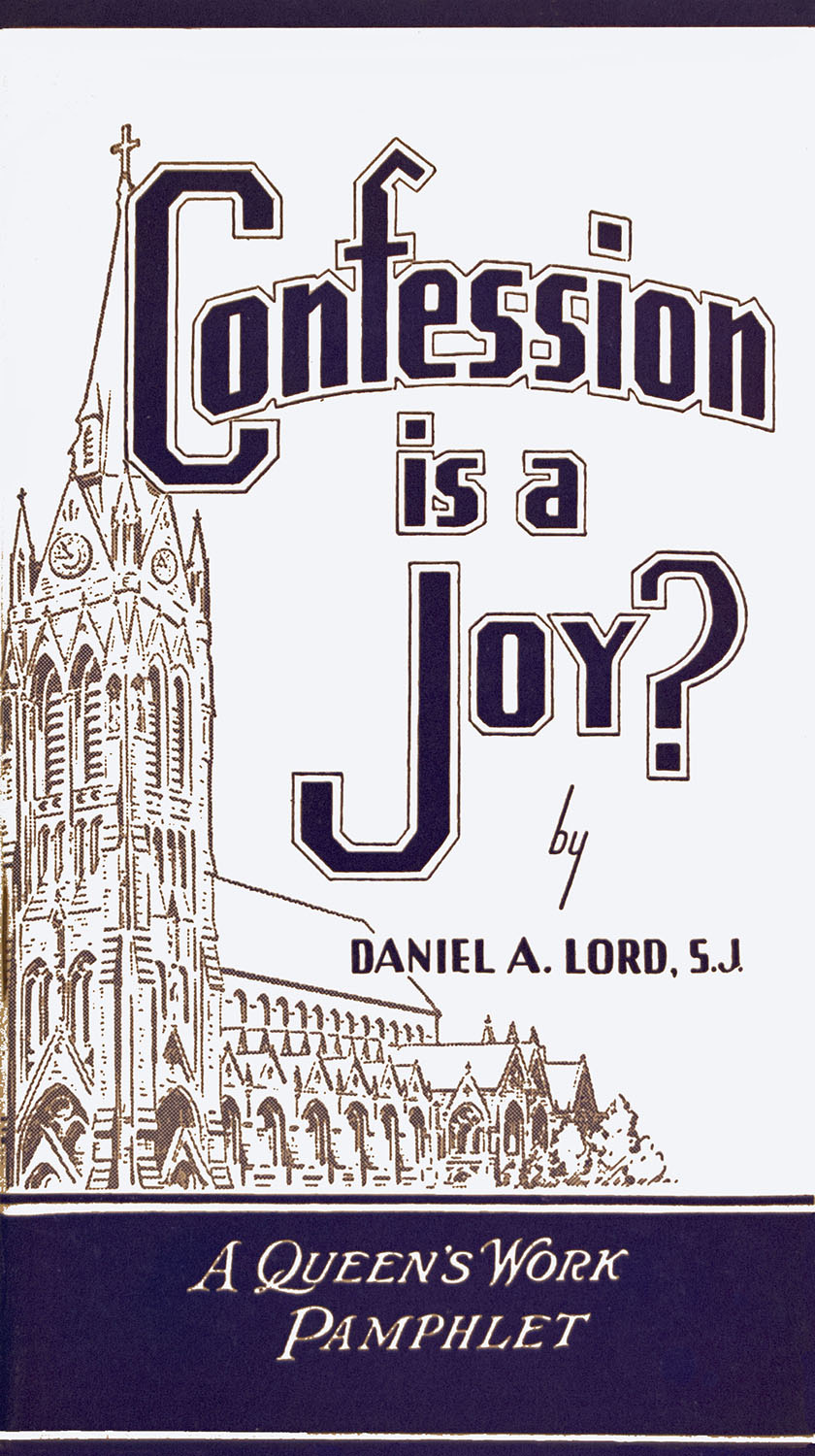
Lord’s best-selling pamphlets were Confession is a Joy? (1933), with 36 printings and 340,000 units sold; Going Steady (1941), 23 printings and 295,000 units sold; What to Do on a Date (1939), 31 printings and 294,000 units sold; and Prayers are Always Answered (1927), 33 printings and 280,000 units sold. Assumedly, the success of Confession is a Joy? was not due to the failure of readers to follow the advice in Going Steady and What to Do on a Date.
Lord wrote A Salute to the Men in the Service in 1942. He later recalled: When the USO came across the booklet that we had developed for the young draftees of World War II, they circulated around four million copies of that one khaki-covered booklet.
55
Lord saw his pamphlets as important missionary and apostolic work and so he freely gave permission for them to be translated and reprinted.
I have not bothered to look up the records of translations, but I know the pamphlets have been turned into French, Spanish, German, Portuguese, Italian, and many of the unusual dialects of mission lands. It is something of a joy that some of the pamphlets which I wrote twenty years ago have almost as wide a circulation today as they had the year of publication.56
The pamphlets would also be translated into Polish, Hindi, American Sioux, Persian, some Scandinavian languages, Portuguese, and more. Diocesan papers—with and without permission—as far away as New Zealand and South Africa would reprint the pamphlets. Some were published in Braille versions. No figures exist on foreign sales of Lord’s pamphlets; however, very likely millions were sold and given away overseas.
How many pamphlets did Lord sell in America? William Barnaby Faherty, the eminent St. Louis Jesuit historian, who worked on the Queen’s Work staff and knew Daniel Lord put the figure at 25 million, but this is too low. Lord himself gave a figure of 165 pamphlets with sales of almost 28 million in 1948. (He also gave the numbers of 21 books with 185,354 sold and 23 plays published with 37,670 sold.) Lord kept writing and selling pamphlets until he died in 1955. They continued to be printed and sold until 1963 when Liguori Publications bought out and sold the remaining inventories. A better estimate of Lord’s pamphlet sales would be over 35 million. Also the Queen’s Work published pamphlets by others. No reliable numbers exist but many millions of these were sold.
Weaknesses in the PamphletsTo a modern reader, several weaknesses show up from time to time in Lord’s pamphlets. He presented an idealized view of the Church. A product of his times, some of his views are outdated and some his views of history were romanticized. Lord had a theology of happiness that at times seems simplistic. Lastly, in a few instances Lord presented a harsh image of God.
Lord spoke as an idealist about faith and the church which is not surprising since he wanted to encourage faith and belief. As “The Great American Catholic Salesman” why would he emphasize the faults of his product? However, Lord’s bigger concern was to answer false criticisms against the church at a time of lingering anti-Catholic prejudice.
Lord was a product of his time which shows up in some of his arguments against birth control. Also Lord, typical for his time, lacked a critical view on some historical events such as the Crusades.
Lord had a theology of happiness which he never fully articulated, yet it comes through frequently in his writing. He believed that holding the truth faith and living morally would bring happiness. As part of this view, he thought that young people would find happiness in becoming sisters, brothers, and priests. To some current readers this might seem simplistic. It also ignored the frequency of the religious people who were not happy people.
Lastly in a few of his pamphlets, Lord presented a harsh image of God. In his 1936 pamphlet, Forever and Forever Lord gave a vivid description of eternal damnation for marrying a divorced woman. Glen Murray, normally a sound sleeper, tosses and turns after his date with Phyllis, a divorcée:
Almost he felt as if he had been given a gambler’s hunch, the hunch to play his coin, the prospects of an immediate happiness in order to win forever and forever. If he played his coin upon Phyllis (he drew back from the crudeness of the phrase; then plunged his mind relentlessly into it), if he played his coin upon Phyllis and lost and there was a forever, a forever in which he would sit, imprisoned with no releasing jailer, sick with no merciful death, a failure with no chance to retrieve lost fortunes—forever sick of himself, sick of his failure, tormented as failures are tormented and knowing that not next year, nor after a million years nor after a hundred billion, nor after the sun’s fire had cooled to a cold ash, and the last planet was sifted in fine dust vaguely through barren space, would it end for him or for his memory and his bitterness.57
However this type of passage is rare in Lord’s writing.
The Importance of Lord’s Pamphlets
In his pamphlets, Lord created a body of literature covering a wide range of subjects related to Catholic faith and life. He became “The Great America Catechist, Apologist, and Salesman” as he wrote to a ready audience in the Sodality members. Since his pamphlets and books wound up in most parishes and most Catholic high school and colleges in America, he did more than anyone to educate Catholics about their faith.
Although pamphlet writing is a thing of the past, it shares many of the features of modern electronic communication: the message must be short and to the point, and it must grab and hold the reader’s interest. The size of a quick message has gone from 32 pamphlet pages to 140 Twitter characters, however, the approach of Daniel Lord provides valuable lessons about how to communicate, especially to young people. The technology has changed dramatically, yet most of the problems that people face remain the same.

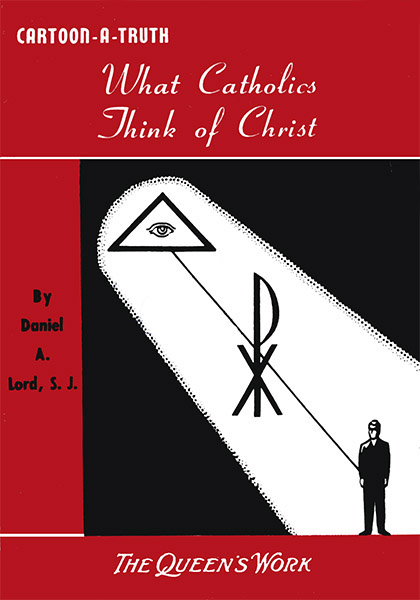
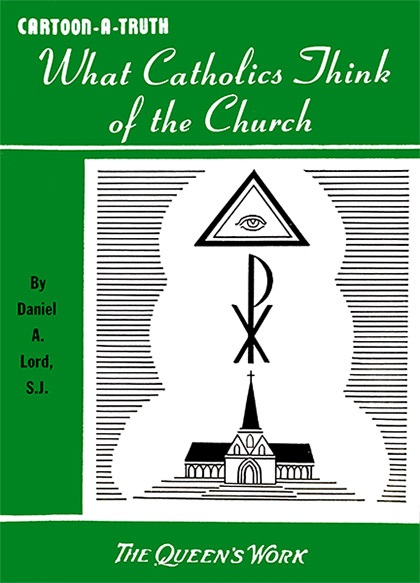
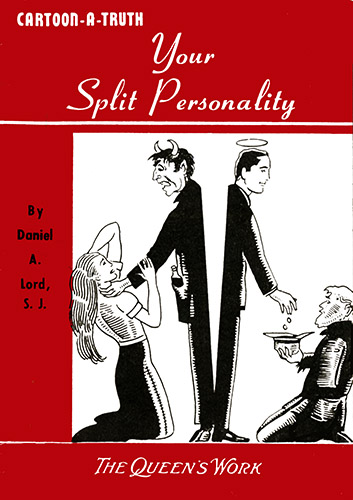
NOTES
- 1 Thomas F. Gavin, S.J., Champion of Youth: A Dynamic Story of a Dynamic Man: Daniel A. Lord, S.J. (Boston: Daughters of St. Paul, 1977); 176.
- 2 William Barnaby Faherty, Dream by the River: Two Centuries of Saint Louis Catholicism, 1766-1980, (Saint Louis: Piraeus, 1973), 177.
- 4 Daniel A. Lord, S.J., “This Master of Pamphlets: America's ace Catholic pamphleteer has reason to know that the pen is still mightier than the sword.” St. Joseph Magazine (September, 1938), 2-4.
- 4 Lord’s life is covered in Daniel A. Lord, S.J., Played By Ear; My Mother (St. Louis: The Queen’s Work, 1934), and Hi, Gang! (St. Louis: The Queen’s Work, 1941); Rev. Thomas F. Gavin, S.J., Champion of Youth: A Dynamic Story of a Dynamic Man: Daniel A. Lord, S.J.: and Joseph T. McGloin, S.J., Backstage Missionary: Father Dan Lord, S.J. (New York: Pageant Press, 1958). A recent tribute is David J. Endres, “Dan Lord, Hollywood Priest,” America, 193 (December 12, 2005), 20-21. See also Endres, “The Global Missionary Zeal of an American Apostle: The Early Works of Daniel A. Lord, 1922-1929,” U.S. Catholic Historian: 24 (Summer 2006), 39-94; and William Barnaby Faherty, Better the Dream, Saint Louis: University & Community, 1818-1968 (St. Louis: St. Louis University, 1968); and “A Half-Century of the Queen’s Work,” Woodstock Letters, 92 (1963): 99-114.
- 5 Daniel A. Lord, S.J., “Schools of Catholic Action”, Studies (September 1933), 454–67; “Sodalities in America and Catholic Action,” Studies (June 1933), 257-70.
- 6 Faherty, Dream by the River, 159. See also William D. Dinges “‘An Army of Youth’: The Sodality Movement and the Practice of Apostolic Mission,” U.S. Catholic Historian 19, no. 3 (2001): 35-49.
- 7 Several biographies on DeMille describe Lord’s role on the movie such as Cecilia DeMille Presley and Mark A. Viera, Cecil B. DeMille: The Art of the Hollywood Epic (Philadelphia: Running Press, 2014), 131-32.
- 8 A number of books talk about Lord’s role in writing the Code such as Gregory D. Black, Hollywood Censored: Morality Codes, Catholics, and the Movies (Cambridge University Press, 1996); and Frank Walsh, Sin and Censorship: the Catholic Church and the Motion Picture Industry (New Haven: Yale University Press, 1996).v
- 9 Arnold Sparr, To Promote, Defend, And Redeem: The Catholic Literary Revival And The Cultural Transformation Of American Catholicism, 1920-1960 (New York: Greenwood Press, 1990), devotes an entire chapter to Lord: “A Revival is Organized: Daniel A. Lord and the Sodality Literary Campaign,” 31-50. See also Jay P. Dolan, In Search of an American Catholicism: A History of Religion and Culture in Tension (New York: Oxford University Press: 2002), 151. Stephen A. Werner, “Joseph Husslein and the American Catholic Literary Revival: ‘A University in Print,” Catholic Historical Review 87 (October 2001): 688-705.
- 10 Jay P. Dolan, The American Catholic Experience: A History from Colonial Times to the Present (Garden City, Doubleday, 1985), 386.
- 11 Gavin, Champion of Youth, 78.
- 12 Lord, Atheism Doesn’t Make Sense (St. Louis: Queen’s Work, 1936), 29.
- 13 Lord, I Can Read Anything, (St. Louis: Queen’s Work, 1930), 30.v
- 14 Lord, The Little Flower and the Blessed Sacrament (New York: Benziger Brothers, 1925).
- 15 Lord, “Master of Pamphlets,” 2.
- 16 Ibid., 2.
- 17 Ibid., 3.v
- 18 Lord, Played by Ear, 323.v
- 19 Lord, “Master of Pamphlets,” 4.
- 20 Lord, Played by Ear, 304-305.v
- 21 Lord, The Church Is A Failure? (St. Louis: Queen’s Work, 1939), 13.
- 22 Ibid., 14.
- 23 Ibid., 14.
- 24 Lord, Murder in the Classroom: The Summer Colonists Discuss Catholic Education (St. Louis: Queen’s Work, 1931), 23-24. The first printing had the title: Go to a Catholic College.
- 25 Lord, Do You Love Your Children? (St. Louis: Queen’s Work, 1952), 13, 18.
- 26 George C. Stewart, Marvels of Charity: History of American Sister and Nuns (Huntington, Indiana: Our Sunday Visitor Publishing Division, 1994), 320-29.
- 27 Lord, Spinsters are Wonderful People: In Praise of Unmarried Women (St. Louis: Queen’s Work, 1947), 7.
- 28 Lord, The Chance of a Lifetime (St. Louis: Queen’s Work, 1946), 17.
- 29 Ibid., 8.
- 30 Ibid., 11.
- 31 Ibid., 11.
- 32 Lord, You’ve a Right to Be Happy (St. Louis: Queen’s Work, 1940), 3-4.
- 33 Lord, How to Stay Young (St. Louis: Queen’s Work, 1940), 12-13.
- 34 Ibid., 20.
- 35 Lord, Hours Off: What We Do When We Do Nothing (St. Louis: Queen’s Work, 19432), 11.
- 36 Lord, Played by Ear, 334.
- 37 Lord, Your Partner in Marriage (St. Louis: Queen’s Work, 1936), 15.
- 38 Ibid., 15.
- 39 Ibid., 29.
- 40 Lord, Love’s All That Matters (St. Louis: Queen’s Work, 1948), 25.
- 41 L ord, Romance is Where You Find It (St. Louis: Queen’s Work, 1947), 40.
- 42 Lord, The Best Best Seller (St. Louis: Queen’s Work, 1932), 29.
- 43 Ibid., 30.
- 44 Lord, For Christ the King (St. Louis: Queen’s Work, 1932).
- 45 Lord, The Call to Catholic Action (St. Louis: Queen’s Work, 1933), 23.
- 46 Ibid., 29-30.
- 47 Lord, “I Can Take It or Leave It Alone” (St. Louis: Queen’s Work, 1939), 11. A quick summary of Lord views on drinking is found in his booklet The Questions They Always Ask (St. Louis: Queen’s Work, 1943), 17-21.
- 48 Lord, “I Can Take It or Leave It Alone,” 24.
- 49 Ibid., 28-29.
- 50 Lord, God and the Depression (St. Louis: Queen’s Work, 1932), 10-11.
- 51 Lord, Success For the Taking: . . . Winning Careers (St. Louis: Queen’s Work, 1948), 30-31.
- 52 Lord, What Catholicity and Communism Have in Common (St. Louis: Queen’s Work, 1936), 22-23.
- 53 Ibid., 23.
- 54 Ibid., 14-15.
- 55 Lord, Played by Ear, 333. See Gavin, Champion of Youth, 130.
- 56 Lord, Played by Ear, 333.
- 57 Lord, Forever and Forever (St. Louis: Queen’s Work, 1936), 21-22.